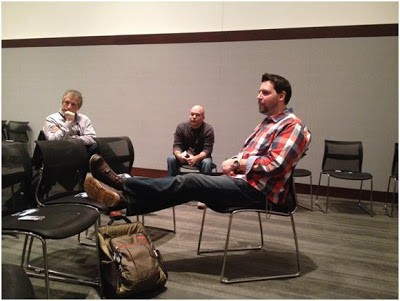This session was a fairly small and intimate gathering with a lot of give-and-take. At the outset everyone agreed that the devices to be discussed would be limited to smartphones and tablets rather than desktops or laptops. Personally, as someone who brings a laptop into the office every day, I think they should have been included but that’s just me.
Daniel Gerow – who does corporate IT at Wayfair, a $600M home goods etailer – was the host of our little band.
 |
| Daniel Gerow of Wayfair and participants at the BYOMD Panel. |
At the outset, he asked everyone to share some topics that were of interest. Here they are with the discussion around them:
Security – this came up a lot, in terms of securing the data on a device and providing devices with secure access to enterprise data. Policies were one approach to security, but they – it was agreed – are not especially strong, difficult to enforce and better in theory than in practice.
One of the most interesting discussions (as far as I was concerned) was around technologies that created secure devices on an existing device – not exactly virtual, but separated and running in parallel. Two companies were mentioned. The first was Enterproid, whose product – Divide – allows an enterprise to create a secure phone on an existing one. By tapping the home button twice the secure device is invoked. It can then access enterprise resources and corporate IT has centralized management capabilities. Double tap again and the phone is your personal one once again.
The second company was MobileSpace. This takes a different approach. It “wraps” applications (no one was quite able to say how exactly “wrapping” worked) and only those apps were able to access the enterprise.
The centralized management offered by both was a big.
This is easy to understand when you consider the second issue that came up: Fragmentation.
Gerow explained that for him, everything was about standardization. He doesn’t want to have to think about or manage all of these different devices, operating systems and OS variants. Wayfair is a Microsoft shop and so he is able to use ActiveSync to manage all the devices that come through the door (assuming they all support ActiveSync of course). He asks employees wanting to use their own devices what they plan to use them for and is then able to configure policies and permissions based on their specific use case.
The next topic focused on people’s assumptions about the mobile experience. This became a pretty freewheeling topic and covered a lot of ground. One of the elements of the discussion was storage and how frequently people are using services like DropBox to move files from work to home and back again – whether on a mobile device or otherwise. Everyone agreed that access to corporate data without corporate control was a big issue. The challenge is that dealing with VPNs – especially on mobile devices – is not a great experience. It’s just so much easier to set up a DropBox.
Although no one was able to name a specific product, several people said there are enterprise solutions with DropBox like capabilities – but without the public cloud storage. If it’s easy people will use it, if not they’ll do it there way.
The other user experience issue had to do with live data. One participant discussed healthcare apps that allow caregivers to access and update records from their mobile devices or a PC. Because these are busy people, most tend to want to use their device. This creates a new set of challenges – encryption, performance and maintaining data state if a mobile device loses its connection to the network.
The bottom line is that the technology is in place and people are using it in the workplace. Yes, it raises issues and concerns but the genie isn’t going back in the bottle. Of course many enterprises hold a digital trump card:
If a device is ever lost or compromised, it can be wiped – killing all the data, personal and enterprise.